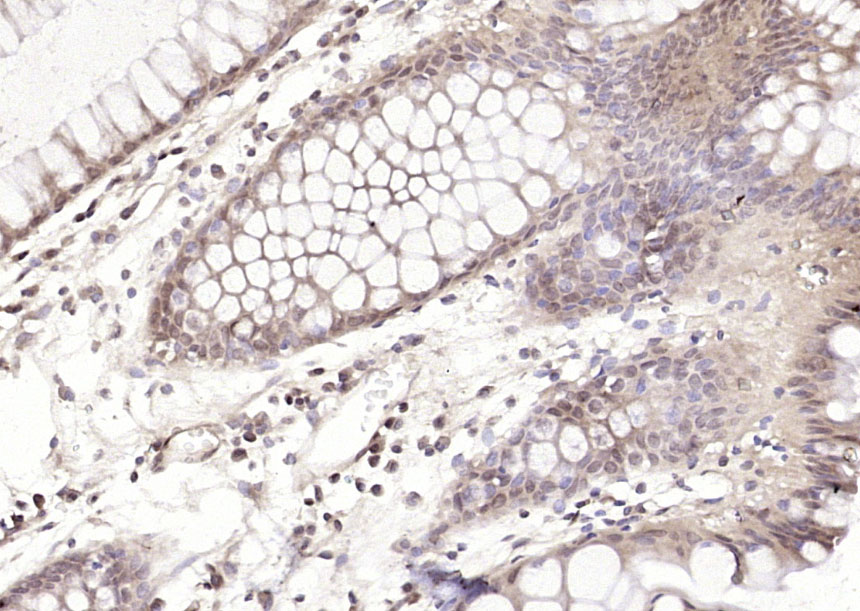
Rabbit Anti-RBX1 antibody
RBX1_HUMAN; E3 ubiquitin-protein ligase RBX1; EC:2.3.2.27; EC:2.3.2.32; RNF75; ROC1; E3 ubiquitin-protein transferase RBX1; Protein ZYP; RING finger protein 75; RING-box protein 1 (Rbx1); Regulator of cullins 1 (ROC1); E3 ubiquitin-protein ligase RBX1, N-
View History [Clear]
Details
Product Name RBX1 Chinese Name Ring finger protein75抗体 Alias RBX1_HUMAN; E3 ubiquitin-protein ligase RBX1; EC:2.3.2.27; EC:2.3.2.32; RNF75; ROC1; E3 ubiquitin-protein transferase RBX1; Protein ZYP; RING finger protein 75; RING-box protein 1 (Rbx1); Regulator of cullins 1 (ROC1); E3 ubiquitin-protein ligase RBX1, N-terminally processed; E3 ubiquitin-protein transferase RBX1, N-terminally processed; Research Area Cell biology Chromatin and nuclear signals Epigenetics Immunogen Species Rabbit Clonality Polyclonal React Species Human, Mouse, (predicted: Rat, Cow, ) Applications WB=1:500-2000 ELISA=1:5000-10000 IHC-P=1:100-500 IHC-F=1:100-500 IF=1:50-200 (Paraffin sections need antigen repair)
not yet tested in other applications.
optimal dilutions/concentrations should be determined by the end user.Theoretical molecular weight 12kDa Cellular localization The nucleus cytoplasmic Form Liquid Concentration 1mg/ml immunogen KLH conjugated synthetic peptide derived from human RBX1: 1-70/108 Lsotype IgG Purification affinity purified by Protein A Buffer Solution 0.01M TBS(pH7.4) with 1% BSA, 0.03% Proclin300 and 50% Glycerol. Storage Shipped at 4℃. Store at -20 °C for one year. Avoid repeated freeze/thaw cycles. Attention This product as supplied is intended for research use only, not for use in human, therapeutic or diagnostic applications. PubMed PubMed Product Detail This locus encodes a RING finger-like domain-containing protein. The encoded protein interacts with cullin proteins and likely plays a role in ubiquitination processes necessary for cell cycle progression. This protein may also affect protein turnover. Related pseudogenes exist on chromosomes 2 and 5.[provided by RefSeq, Sep 2010]
Function:
E3 ubiquitin ligase component of multiple cullin-RING-based E3 ubiquitin-protein ligase complexes which mediate the ubiquitination and subsequent proteasomal degradation of target proteins, including proteins involved in cell cycle progression, signal transduction, transcription and transcription-coupled nucleotide excision repair. The functional specificity of the E3 ubiquitin-protein ligase complexes depends on the variable substrate recognition components. As a component of the CSA complex promotes the ubiquitination of ERCC6 resulting in proteasomal degradation. Through the RING-type zinc finger, seems to recruit the E2 ubiquitination enzyme, like CDC34, to the complex and brings it into close proximity to the substrate. Probably also stimulates CDC34 autoubiquitination. May be required for histone H3 and histone H4 ubiquitination in response to ultraviolet and for subsequent DNA repair. Promotes the neddylation of CUL1, CUL2, CUL4 and CUL4 via its interaction with UBE2M. Involved in the ubiquitination of KEAP1, ENC1 and KLHL41.
Subunit:
Part of a SCF complex consisting of CUL1, RBX1, SKP1 and SKP2. Part of a SCF-like complex consisting of CUL7, RBX1, SKP1 and FBXW8. Part of CBC(VHL) complexes with elongin BC complex (TCEB1 and TCEB2), CUL2 or CUL5 and VHL. Part of the CSA complex (DCX(ERCC8) complex), a DCX E3 ubiquitin-protein ligase complex containing ERCC8, RBX1, DDB1 and CUL4A; the CSA complex interacts with RNA polymerase II; upon UV irradiation it interacts with the COP9 signalosome and preferentially with the hyperphosphorylated form of RNA polymerase II. Part of multisubunit E3 ubiquitin ligase complexes with elongin BC complex (TCEB1 and TCEB2), CUL2 and MED8; elongin BC complex (TCEB1 and TCEB2), CUL5 and MUF1. Part of multisubunit complexes with elongin BC complex (TCEB1 and TCEB2), elongin A/TCEB3 or SOCS1 or WSB1 and CUL5. Interacts directly with CUL1 and probably also with CUL2, CUL3, CUL4A, CUL4B, CUL5 and CUL7. Probably interacts with CDC34. Interacts with COPS6. Component of the DCX DET1-COP1 ubiquitin ligase complex at least composed of RBX1, DET1, DDB1, CUL4A and COP1. Part of an E3 ligase complex composed of RBX1, DDB1, DDB2 and CUL4A or CUL4B. Interacts with UBE2M. Part of a SCF complex consisting of CUL1, FBXO3, RBX1 and SKP1; this complex interacts with PML via FBXO3. Interacts with human adenovirus early E1A protein; this interaction inhibits RBX1-CUL1-dependent elongation reaction of ubiquitin chains by the SCF(FBW7) complex. Component of the SCF(Cyclin F) complex consisting of CUL1, RBX1, SKP1 and CCNF. Identified in a SCF (SKP1-CUL1-F-box protein) E3 ubiquitin ligase complex together with HINT1 and CDC34. Component of multiple BCR (BTB-CUL3-RBX1) E3 ubiquitin-protein ligase complexes formed of CUL3, RBX1 and a variable BTB domain-containing protein. Part of the BCR(ENC1) complex containing ENC1. Part of the BCR(GAN) complex containing GAN. Part of the BCR(KLHL41) complex containing KLHL41. Part of the BCR(KEAP1) complex containing KEAP1.
Subcellular Location:
Cytoplasm. Nucleus.
Tissue Specificity:
Widely expressed.
Similarity:
Belongs to the RING-box family.
Contains 1 RING-type zinc finger.
SWISS:
P62877
Gene ID:
9978
Database links:Entrez Gene: 9978 Human
Entrez Gene: 56438 Mouse
SwissProt: P62877 Human
SwissProt: P62878 Mouse
Product Picture
References (0)
No References
Bought notes(bought amounts latest0)
No one bought this product
User Comment(Total0User Comment Num)
- No comment




 +86 571 56623320
+86 571 56623320
 +86 18668110335
+86 18668110335

